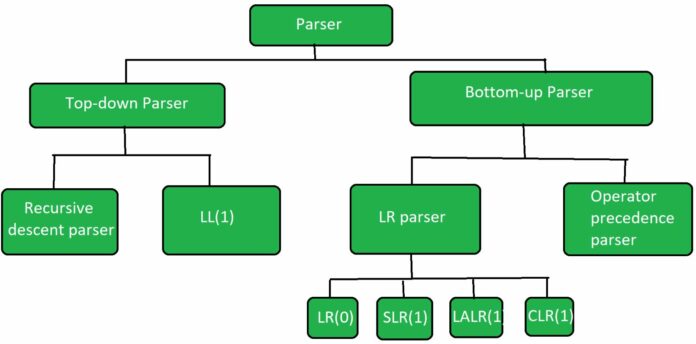Parsing syntax analysis, or syntactic analysis is the process of analyzing a string of symbols, either in natural language, computer languages or data structures, conforming to the rules of a formal grammar. The term parsing comes from Latin pars (orationis), meaning part (of speech).
The term has slightly different meanings in different branches of linguistics and computer science. Traditional sentence parsing is often performed as a method of understanding the exact meaning of a sentence or word, sometimes with the aid of devices such as sentence diagrams. It usually emphasizes the importance of grammatical divisions such as subject and predicate.
Within computational linguistics the term is used to refer to the formal analysis by a computer of a sentence or other string of words into its constituents, resulting in a parse tree showing their syntactic relation to each other, which may also contain semantic and other information (p-values). Some parsing algorithms may generate a parse forest or list of parse trees for a syntactically ambiguous input.
The term is also use in psycholinguistics when describing language comprehension. In this context, parsing refers to the way that human beings analyze a sentence or phrase (in spoken language or text) “in terms of grammatical constituents, identifying the parts of speech, syntactic relations, etc.” This term is especially common when discussing what linguistic cues help speakers to interpret garden-path sentences.
What is the role of parser?
The parser obtains a string of tokens from the lexical analyzer and verifies that the string can be the grammar for the source language. It detects and reports any syntax errors and produces a parse tree from which intermediate code can be generated.
Which parser is most powerful?
Canonical LR is the most powerful parser as compared to other LR parsers.
Why CLR parser is most powerful?
When the parser looks ahead in the input buffer to decide whether the reduction is to be done or not the information about the terminals is available in the state of the parser itself which is not in case of SLR parser state. Hence CLR(1) parser is more powerful than SLR.
Why do we need parsing?
Fundamentally, parsing is necessary because different entities need the data to be in different forms. Parsing allows transforming data in a way that can be understood by a specific software. The obvious example is programs — they write by humans, but they must be executed by computers.
Is recursion good or bad for parsing?
With right recursive grammars, the stack may grow indefinitely until a reduction occurs, thus limiting rather dramatically the parsing possibilities. However, left recursive ones will let the compiler generate reductions earlier (in fact, as soon as possible).
Why do we need to parser first information?
So FOLLOW can make a Non-terminal to vanish out if needed to generate the string from the parse tree. The conclusions is, we need to find FIRST and FOLLOW sets for a given grammar, so that the parser can properly apply the needed rule at the correct position.
Which bottom-up parser is best?
LR Parser. The LR parser is a non-recursive, shift-reduce, bottom-up parser. It uses a wide class of context-free grammar which makes it the most efficient syntax analysis technique.
Is LR 0 and SLR same?
The only difference between LR(0) and SLR(1) is this extra ability to help decide what action to take when there are conflicts. Because of this, any grammar that can be parse by an LR(0) parser can be parsed by an SLR(1) parser. However, SLR(1) parsers can parse a larger number of grammars than LR(0).
What does parsing mean in coding?
To parse is to break up a sentence or group of words into separate components, including the definition of each part’s function or form. Parsing uses in all high-level programming languages. Languages like C++ and Java are parse by their respective compilers before being transform into executable machine code.





